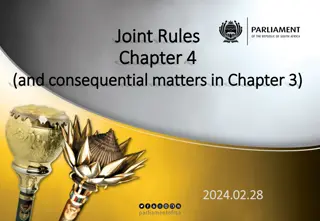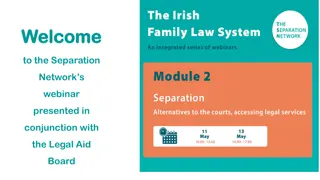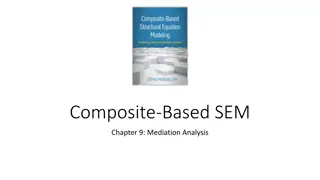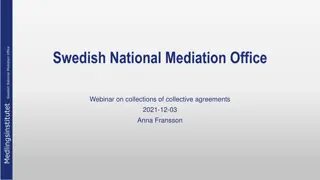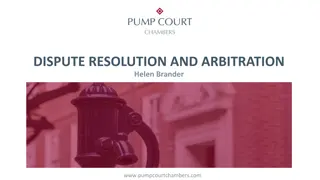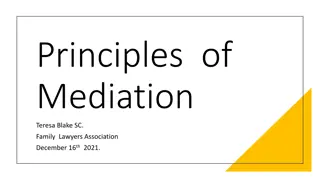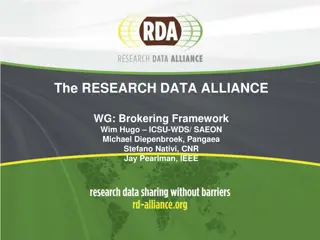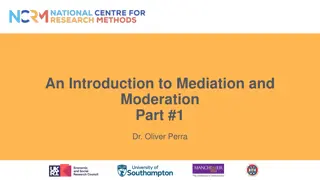Overview of Mediation Process Strategic Directions
This article delves into the strategic directions guiding the mediation process, emphasizing key themes such as sustainability, resilience, and economic prosperity in Dunedin. Explore the role of strategic directions, management approaches, and the purpose behind these guiding principles.
Download Presentation

Please find below an Image/Link to download the presentation.
The content on the website is provided AS IS for your information and personal use only. It may not be sold, licensed, or shared on other websites without obtaining consent from the author.If you encounter any issues during the download, it is possible that the publisher has removed the file from their server.
You are allowed to download the files provided on this website for personal or commercial use, subject to the condition that they are used lawfully. All files are the property of their respective owners.
The content on the website is provided AS IS for your information and personal use only. It may not be sold, licensed, or shared on other websites without obtaining consent from the author.
E N D
Presentation Transcript
Running order Introduction to Mediation Process Strategic Directions Variation 2
Role of strategic directions Questions from pre-hearing conference (Answered in affidavit 16 April and 14 May) Questions from informal discussions do the strategic directions objectives and policies trump the objectives and policies in the topic/zone sections (sections B- E)? Transpower appeal amend introduction to remove paragraph saying most relevant to the assessment of resource consent applications for non-complying activities, but they may also be relevant for other resource consent applications, particularly in considering cumulative effects. because such an approach may write down the weight given to policies that relate to enabling and protecting the National Grid elsewhere in the Proposed Plan
values.Purpose of Strategic Directions section Sets out the overall strategic objectives that the Plan is seeking to achieve based on the key issues for the city and the areas required to be addressed as matters of national importance (s6) and other matters (s7) under Part 2 of the Act. Strategicpolicies under those objectives that primarily describe the management approaches used in the Plan to achieve those objectives.
values. Types of management approaches The use of zones and overlays (overlay zones and mapped areas) to logically organise objectives, policies and rules based on spatial areas with similar objectives or issues to be managed The use of scheduled buildings, sites, places The use of scheduled activities (scheduled mines) Rules (activity status, performance standards); and Where policies lead to rules which require resource consent, use of a drafting protocol for policies to ensure they provide clear guidance to support the assessment of consent applications and Supporting that policy direction with assessment guidance and additional information in appendices, for example, summaries of values to be protected and design guidelines to help protect values.
Strategic Directions - Overall Directions /themes The strategic directions objectives and policies are grouped under six key themes: Dunedin is Environmentally Sustainable and Resilient Dunedin is Economically and Socially Prosperous Dunedin is a Memorable City with a Distinctive Built and Natural Character Dunedin is a City that Gives Effect to the Principles of the Treaty of Waitangi, Protects K i Tahu Values, Culture and Traditions, and Enables K i Tahu to Express Kaitiakitaka Dunedin has Quality Housing Choices and Adequate Urban Land Supply Dunedin has Affordable and Efficient Public Infrastructure.
Affidavit 16 April 2019 Column A: Provision Number Column B: Provision Content Column C: Is the role of the strategic direction policy to outline methods in the Plan? Column D: Is the strategic direction designed to be used in assessing resource consents? Column E: Does the Plan provide guidance on the horizontal alignment and/or primacy between strategic directions in relation to this strategic direction objective or policy, including does the strategic direction gives guidance on the primacy or horizontal alignment of objectives or are there rules that implement it that provide guidance on that. Column F: How and where are the strategic directions incorporated into lower order objectives and policies and rules? Column G: Summary of appeal points on the strategic direction Column H: Appeals on related provisions that may affect this Strategic Direction (e.g. require a consequential change to the Strategic Direction) Column I: Appeals on related provisions that may (purposefully or unavoidably) affect the Drafting Protocol Column J: Appeals on related provisions that are unlikely to affect either this Strategic Direction or the Drafting Protocol Policy 2.2.1.3 Identify areas with risk from terrestrial flooding, and include these in hazard overlay zones as follows: a. in the Hazard 1A (flood) Overlay Zone, include areas that are part of a flood protection scheme which have a crucial role in the conveyance or storage of floodwater where there may be a high risk to people and property and of transference or exacerbation of risk elsewhere; b. in the Hazard 1 (flood) Overlay Zone, include areas that have a crucial role in the conveyance or storage of floodwater where there may be a high risk to people and property and of transference or exacerbation of risk elsewhere, but where prohibited activity status is not seen as appropriate; c. in the Hazard 2 (flood) Overlay Zone, include areas in a floodplain where there may be a moderate risk to people and property, and of transference or exacerbation of risk elsewhere; d. in the Hazard 3 (flood) Overlay Zone, include areas that are vulnerable to short term surface flooding but where there may be a low risk to people and property; and e. in the Hazard 3 (alluvial fan) Overlay Zone, include areas that could be subject to flooding, including sediment-laden flows, but where there may be a low risk to people and property and of transference or exacerbation of risk elsewhere. Yes No No Mapping of hazard (flood) and hazard (alluvial fan) overlay zones. Yes - Blueskin Projects Limited and Others (149) Natural Hazards Strategic topic (Group 1): - Blueskin Projects Limited and Others (149) request to remove Hazard 2 (flood), Hazard 3 (flood) and Hazard 3 (coastal) overlay zones (and associated rules). No Natural Hazards Mapping topic (Group 4): - Anthony Reid and Hilary Evans (365) request to remove Hazard 3 (flood) Overlay Zone from property. - Otago Regional Council (94) request to include area in Hazard 1A (flood) Overlay Zone.
Affidavits 16 April 2019 & 14 May Discussed purpose of Strategic Directions based on 3 options suggested by the Court 16 April Annexure A: Column C showed which are about outlining methods (as the main purpose) Columns D if linked to consents assessment guidance (also highlighting where fully incorporated into topic/zone objs/pols which is detailed in Column F)
Affidavit 16 April 2019 Column E how guidance on horizontal alignment and/or primacy between strategic directions is provided in the Plan Analysis considers question in terms of the strategic directions and the objectives and policies and rules in zone/topic sections that flow from them Horizontal alignment - through cross referencing and linking between SD policies and explanations in assessment guidance Primacy through drafting protocol/ directiveness and strength of language, through policy wording that directs achievement of another objective or policy (gives it primacy), through types of rules that flow from balancing different objectives (more lenient approach for some activities) and sometimes in assessment rules/guidance 14 May additional information on the 3 instances where this is done through strategic direction policy wording
Affidavit 16 April 2019 Sorted appeal points against related SD and whether appeal affects SD objective or policy or drafting protocol Columns G/H direct appeals on strategic directions and initial analysis of where relief sought may require consequential change to a SD objective or policy Columns I appeals at odds with drafting protocol Column J neither of above
Affidavit 16 April 2019 Column A: Provision Number Column B: Provision Content Column C: Is the role of the strategic direction policy to outline methods in the Plan? Column D: Is the strategic direction designed to be used in assessing resource consents? Column E: Does the Plan provide guidance on the horizontal alignment and/or primacy between strategic directions in relation to this strategic direction objective or policy, including does the strategic direction gives guidance on the primacy or horizontal alignment of objectives or are there rules that implement it that provide guidance on that. Column F: How and where are the strategic directions incorporated into lower order objectives and policies and rules? Column G: Summary of appeal points on the strategic direction Column H: Appeals on related provisions that may affect this Strategic Direction (e.g. require a consequential change to the Strategic Direction) Column I: Appeals on related provisions that may (purposefully or unavoidably) affect the Drafting Protocol Column J: Appeals on related provisions that are unlikely to affect either this Strategic Direction or the Drafting Protocol Policy 2.2.1.3 Identify areas with risk from terrestrial flooding, and include these in hazard overlay zones as follows: a. in the Hazard 1A (flood) Overlay Zone, include areas that are part of a flood protection scheme which have a crucial role in the conveyance or storage of floodwater where there may be a high risk to people and property and of transference or exacerbation of risk elsewhere; b. in the Hazard 1 (flood) Overlay Zone, include areas that have a crucial role in the conveyance or storage of floodwater where there may be a high risk to people and property and of transference or exacerbation of risk elsewhere, but where prohibited activity status is not seen as appropriate; c. in the Hazard 2 (flood) Overlay Zone, include areas in a floodplain where there may be a moderate risk to people and property, and of transference or exacerbation of risk elsewhere; d. in the Hazard 3 (flood) Overlay Zone, include areas that are vulnerable to short term surface flooding but where there may be a low risk to people and property; and e. in the Hazard 3 (alluvial fan) Overlay Zone, include areas that could be subject to flooding, including sediment-laden flows, but where there may be a low risk to people and property and of transference or exacerbation of risk elsewhere. Yes No No Mapping of hazard (flood) and hazard (alluvial fan) overlay zones. Yes - Blueskin Projects Limited and Others (149) Natural Hazards Strategic topic (Group 1): - Blueskin Projects Limited and Others (149) request to remove Hazard 2 (flood), Hazard 3 (flood) and Hazard 3 (coastal) overlay zones (and associated rules). No Natural Hazards Mapping topic (Group 4): - Anthony Reid and Hilary Evans (365) request to remove Hazard 3 (flood) Overlay Zone from property. - Otago Regional Council (94) request to include area in Hazard 1A (flood) Overlay Zone.
Summary message how primacy and alignment achieved Key message the 2GP, like most plans, uses a variety of techniques to balance competing objectives whether they be strategic objectives or objectives for different zones, special values (e.g. heritage/natural environment) or critical activities (e.g. network utilities, major facilities) The balance is reflected in the rules themselves, and where rules lead to resource consents - guidance on how to balance is given in objective and policy wording and in assessment guidance Primacy is not established via having some policy content in strategic directions vs in topic/zone sections (sections B-E) Strategic Directions are what is strategic eg big picture/ overarching it sets the foundation for what the Plan is trying to achieve Topic/ Zone objectives and policies more nuanced and finer-grained (often using clear directive language) and reflect (and designed to achieve) the foundation established by the SD
How are they intended to be used? Consideration of plan changes (zoning/overlays) Non-complying activities, where the key issues of concern are around cumulative effects and/or incompatibility with the purpose of zone (zone integrity) linked from assessment rules Some directive strategic policies that sit across the topics / zones sections (e.g. there is no logical other section for the policy) procedural strategic policies (e.g. they direct aspects of consent processes) When useful linked from assessment rules
Affidavit 16 April 2019 Column A: Provision Number Column B: Provision Content Column C: Is the role of the strategic direction policy to outline methods in the Plan? Column D: Is the strategic direction designed to be used in assessing resource consents? Column E: Does the Plan provide guidance on the horizontal alignment and/or primacy between strategic directions in relation to this strategic direction objective or policy, including does the strategic direction gives guidance on the primacy or horizontal alignment of objectives or are there rules that implement it that provide guidance on that. Column F: How and where are the strategic directions incorporated into lower order objectives and policies and rules? Column G: Summary of appeal points on the strategic direction Column H: Appeals on related provisions that may affect this Strategic Direction (e.g. require a consequential change to the Strategic Direction) Column I: Appeals on related provisions that may (purposefully or unavoidably) affect the Drafting Protocol Column J: Appeals on related provisions that are unlikely to affect either this Strategic Direction or the Drafting Protocol Policy 2.2.3.6 Only consider a biodiversity offset, as a positive effect to be balanced against the adverse effects of an activity, where the offset: a. is proposed to address residual adverse effects after taking steps to first: i. avoid adverse effects; then ii. minimise adverse effects as far as practicable; by 1.mitigating effects and then remedying effects that cannot be mitigated; and 2. ensuring that any on-site rehabilitation or restoration measures will occur as soon as practicable; Yes Yes. Designed to provide direction to consent situations on where biodiversity offsets or environmental compensation may be appropriate. Referenced in Section 10 assessment rules. Policy 2.2.3.7 specifies that biodiversity offsets (Policy 2.2.3.6) should be considered prior to environmental compensation, and that if compensation is used it should address the offsetting criteria in Policy 2.2.3.6 Policies 10.2.1.2 and 10.2.1.3 follow the strategic directions hierarchy of first avoiding adverse effects or ensuring no net loss in biodiversity values, prior to considering biodiversity offsetting or, if offsetting is not practicable, environmental compensation No Biodiversity topic (Group 2): - Forest & Bird (281), on Policy 10.2.1.2, Rules 10.6-10.8 Biodiversity topic (Group 2): - Forest & Bird (282), on Policy 10.2.1.3 Biodiversity topic (Group 2): - Forest & Bird (277), on Definition of No Net Loss Section 10 assessment rules (RD, D, NC activities) include general assessment guidance referring to strategic policies 2.2.3.6 and 2.2.3.7 as well as government guidance on biodiversity offsetting b. is close to the donor site, unless a more distant site will result in a significantly better ecological outcome; c. will result in no net loss and preferably a net gain in biodiversity value; where: i.the biodiversity values gained will be the same or similar to those being lost; ii. any gains in biodiversity values are demonstrably additional to those that may have occurred if the proposed activity had not gone ahead; and iii. the positive effects of the offset last at least as long as the adverse effects of the proposed activity, and preferably in perpetuity;
Drafting Protocol Current Drafting Protocol Suggested additional content for Strategic Directions drafting
Potential improvements to reinforce clarity of purpose Expand detail in Strategic Directions introduction (scope in Transpower appeal?) Potential drafting improvements: Minor drafting improvements to clarify and reinforce role of describing approaches (Variation 1 or via appeals) A small number of instances where strategic policies have content that reads like directive policies to guide consent assessment where this direction is not fully incorporated (e.g. repeated) in topic/zone objectives & policies (so there is reliance on the strategic direction) (for example: 2.3.1.8, 2.3.1.9, 2.6.1.6, 2.4.3.3) note some of this was done purposively as cross-section content but perhaps this is causing confusion
Potential improvements to reinforce clarity of purpose A small number of instances where an approach included in the Plan is missed from summary of approaches in the relevant strategic direction policy (e.g. 2.2.1.3 missing mention of swale mapped area) Adding some links to strategic directions from assessment rules where they may be relevant (cross-section or procedural policies; where relevant for non-complying activities), potentially removing some links where not required. For a small number of overlays, adding clear criteria for their application in the policies as is done for most overlays (amenity route mapped areas, urban biodiversity mapped areas, pedestrian frontages, heritage precincts) Will be addressed through Variation 1, 2 or via appeals, or where more complex and no appeals, through future work
Questions 1. Does the introduction to the Strategic Directions need to change to include more explanation around the purpose (as discussed above), including being very clear that the there is no hierarchy of policies between the Strategic Directions policies and those in the rest of the Plan? 2. Should the drafting protocol (including new content on strategic directions) be included in the Plan itself? 3. Should directive policies that are cross-section be moved into or repeated in sections to ensure all directive policies sit in topic/zone sections (section B-E) to avoid confusion? 4. Has anyone done any testing that has come up with a specific problem?


